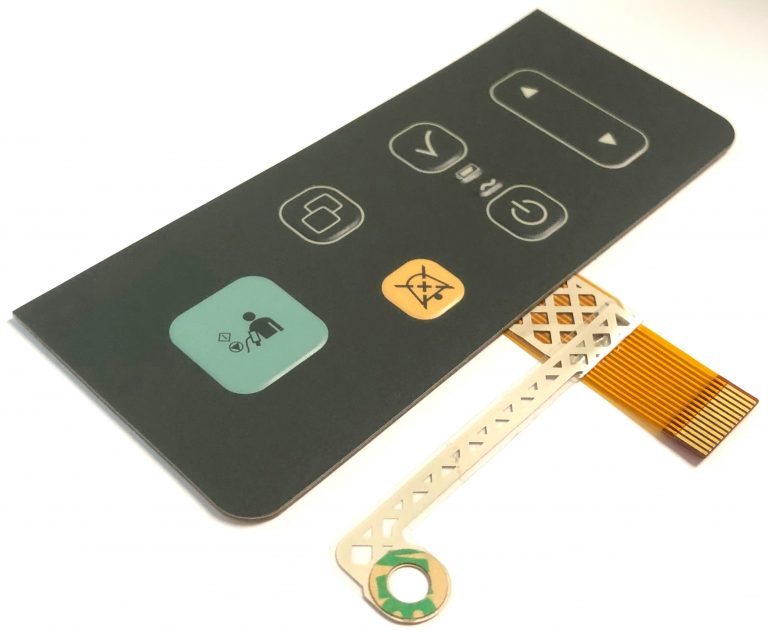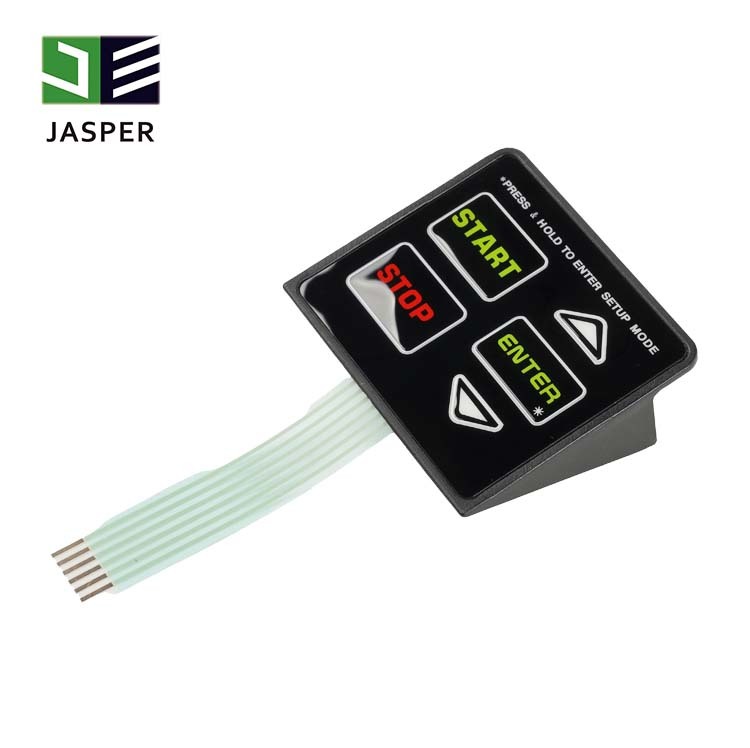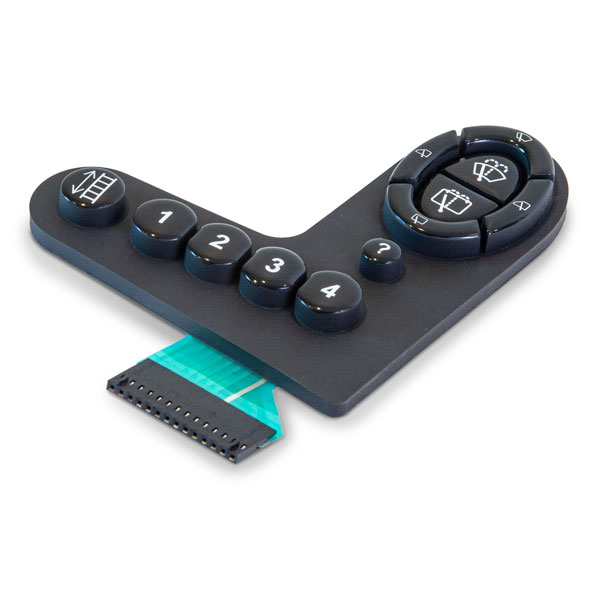The Manufacturing Refine Behind Membrane Switch Over: What You Required to Know
The manufacturing procedure behind membrane changes combines careful layout, material choice, and quality assurance. It starts with recognizing the complexities of membrane button design and progresses with various stages, consisting of material choices and printing techniques. Each stage plays an important function in making sure capability and durability. Nevertheless, the complexities of layer building and the strenuous testing criteria may expose understandings that are not immediately noticeable. What exists beyond these foundational aspects?
Recognizing Membrane Switch Layout
Although membrane switches might show up simple at very first glimpse, their layout entails complex factors to consider that guarantee performance and toughness. The design process begins with a detailed understanding of customer requirements, consisting of the interface's intended application and environmental elements. Comfort designs is a crucial element, as the layout must promote simplicity of use while making sure that responsive comments fulfills user expectations.Moreover, the layering of components, such as graphic overlays, sticky layers, and conductive traces, need to be precisely engineered. membrane switch. This split setup not only influences the button's responsiveness but also affects its durability. Focus is offered to the securing strategies employed to secure versus dampness and dust, which could endanger efficiency. Additionally, layout considerations extend to appearances, where color plans and visual clarity enhance individual experience. Eventually, the layout of membrane switches equilibriums capability, customer experience, and toughness, guaranteeing that they meet the needs of various applications effectively
Products Utilized in Membrane Layer Switch Manufacturing
When picking materials for membrane button manufacturing, it is essential to consider both efficiency and toughness. The key products consist of polyester and polycarbonate movies, which supply flexibility and toughness. These movies are frequently covered with adhesive to assure proper bonding to substrates. Conductive inks, normally made up of silver or carbon, are crucial for producing electric connections within the button, enabling trusted operation.Additionally, a protective layer, such as a tough layer, is frequently applied to improve scratch resistance and longevity. The choice of backing product, such as acrylic or foam, can considerably affect the button's tactile feel and total individual experience. Various ecological aspects, consisting of temperature and moisture, need to lead material choice to assure peak efficiency in specific applications. Eventually, the right combination of products adds to the membrane layer button's performance and life-span, making informed options vital for producers.
The Printing Refine: Creating Video and Text
The printing procedure in membrane layer switch manufacturing plays a substantial function in creating premium graphics and message. Different visuals layout techniques are utilized to assure visual allure and capability, while mindful ink choice techniques are essential for sturdiness and efficiency. Recognizing these components is fundamental for attaining ideal lead to membrane switch layout.
Graphic Layout Techniques
Graphic design techniques play a necessary duty in the printing procedure of membrane layer switches, as they specify how graphics and text will inevitably show up on the final item. Effective visuals design entails the calculated usage of colors, designs, and fonts to boost readability and visual allure. Developers usually utilize vector graphics for scalability, ensuring that images remain sharp at various dimensions. In addition, interest to comparison and alignment is vital, as it affects customer communication and visual top quality. The unification of branding elements, such as logo designs, have to be handled with like maintain brand honesty. On the whole, thoughtful graphic layout methods add considerably to the functionality and beauty of membrane layer buttons, impacting customer experience and item efficiency.
Ink Option Techniques
Selecting the ideal ink is essential for achieving the preferred aesthetic high quality and resilience in membrane button manufacturing. Various ink types are made use of, consisting of solvent-based, water-based, and UV-curable inks. Each type provides distinctive characteristics, such as versatility, attachment, and resistance to ecological aspects. Solvent-based inks are often preferred for their durability and lively colors, while water-based inks are a lot more eco-friendly yet might have restrictions in attachment. UV-curable inks provide rapid treating and durable performance. Additionally, color matching strategies ensure that the picked inks straighten with layout specifications. Inevitably, the selection of ink have to think about factors such as application method, substratum compatibility, and end-use needs to attain premium results in membrane layer button graphics and message.
Layer Building and Assembly

Material Choice Process
A cautious selection of products is essential in the production procedure of membrane layer buttons, as it directly affects performance and durability. The primary products made use of include polyester, polycarbonate, and numerous conductive inks. Polyester is frequently preferred for its exceptional resistance to chemicals and abrasion, making it ideal for harsh atmospheres. Polycarbonate, on the other hand, gives exceptional quality and influence resistance, which is advantageous for applications needing exposure and effectiveness. Conductive inks, commonly made up of silver or carbon, are essential for developing reliable electric paths. In addition, the option of sticky materials impacts the total honesty of the button - membrane switch. Examining variables such as ecological direct exposure, tactile comments, and aesthetic requirements overviews manufacturers in choosing the very best materials for their particular applications
Layer Adhesion Strategies
Sticking layers in membrane layer button building and construction is an essential procedure that ensures performance and longevity. Numerous bond strategies are used to secure excellent bonding in between layers, which generally consist of the use of adhesives, warmth, and stress. Pressure-sensitive adhesives (PSAs) are typically used for their ease of application and immediate bonding abilities. Furthermore, thermal bonding techniques can be applied, where warm is used to turn on sticky buildings, securing a strong bond. The choice of attachment method largely depends upon the products entailed and the particular application demands of the membrane button. Appropriate placement and uniform application of adhesives are essential to prevent issues, safeguarding the switch runs effectively throughout its this link intended lifespan.
High Quality Control Procedures
Guaranteeing quality assurance throughout the layer construction and assembly of membrane buttons is important for preserving efficiency and reliability. This process generally includes numerous essential steps, including extensive inspections at each stage of manufacturing. Makers utilize sophisticated testing techniques, such as peel tests and bond analyses, to verify the integrity of layer bonds. In addition, visual assessments are performed to recognize any type of flaws in printing or material variances. Ecological conditions, such as temperature and moisture, are carefully monitored to assure excellent treating and adhesion. Routine calibration of devices assists preserve specific production requirements. By implementing these quality assurance measures, suppliers can substantially reduce the danger of product failure, guaranteeing that the final membrane switches over meet the needed specs and consumer expectations.
Evaluating and Quality Control Steps

Technologies in Membrane Switch Innovation
As developments in modern technology remain to progress, membrane buttons are gaining from ingenious developments that improve their capability and user experience. One notable innovation is the combination of capacitive touch innovation, which enables even more intuitive and receptive customer interfaces. This shift not just enhances aesthetics but also minimizes mechanical deterioration, extending the life-span of the switches.Additionally, innovations in visuals overlay products have brought about enhanced durability and resistance to ecological variables such as wetness and UV light. These materials now supply boosted clarity and brightness, further raising the aesthetic appeal.Furthermore, the incorporation of wise modern technology is changing membrane changes right into interactive control board, making it possible for connectivity with IoT tools. This connection fosters a smooth customer experience, leading the way for applications in various markets, from healthcare to customer electronic devices. Jointly, these technologies setting membrane layer changes as essential parts in contemporary tool layout.
Regularly Asked Questions
The length of time Does the Membrane Switch Over Production Process Take?
The duration of the membrane button production procedure can vary significantly. Factors such as intricacy, materials used, and production volume impact timelines, with normal manufacturing ranging from a couple of days to a number of weeks for completion.
What Are the Common Applications for Membrane Switches?
Membrane buttons are frequently utilized in numerous industries, consisting of vehicle controls, household devices, clinical devices, and consumer electronic devices (membrane switch). Their flexibility and toughness make them perfect for applications needing straightforward interfaces and trusted efficiency you could try here in varied environments
Can Membrane Layer Switches Be Custom-made for Specific Needs?

What Is the Life expectancy of a Typical Membrane Layer Switch?
The life-span of a regular membrane button differs, but typically, it varies from 1 to 5 million cycles. Elements such as usage, environment, and material high quality substantially influence longevity and overall performance gradually.

Are Membrane Changes Eco-friendly?
The ecological friendliness of membrane layer switches varies. Some products used might not be recyclable, while others can be eco-friendly. The total effect relies on making methods and basics products, requiring cautious consideration throughout selection and disposal. The production procedure behind membrane switches over combines cautious style, material choice, and top quality control. It starts with recognizing the complexities of membrane switch layout and progresses with various phases, including product choices and printing strategies. When picking products for membrane button manufacturing, it is crucial to consider both efficiency and sturdiness. A mindful choice of products is important in the manufacturing process of membrane layer buttons, as it straight influences capability and sturdiness. The option of bond technique largely depends on the products entailed and the certain application requirements of the membrane switch.